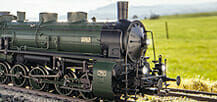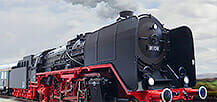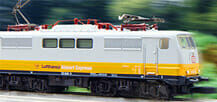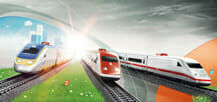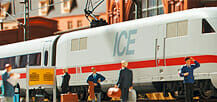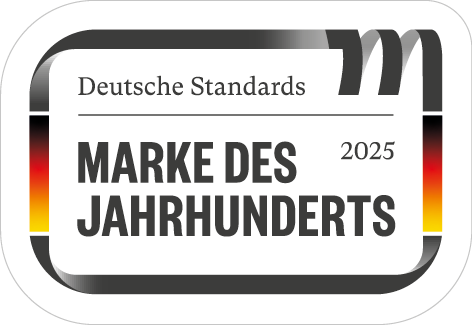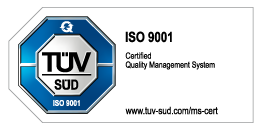EDELWEISS Pullman Car Set
Prototype: Six different parlor cars painted and lettered for the Compagnie Internationale des Wagons-Lits et des Grands Express Européens (CIWL) as EDELWEISS PULLMAN EXPRESS. Two type DD3 baggage cars, one type VPC "Côte d´Azur" parlor car with a galley, one type VP "Côte d´Azur" parlor car without a galley, one type VPC "Étoile du Nord" parlor car with a galley, and one type VP "Étoile du Nord" parlor car without a galley. Train route Amsterdam – The Hague – Rotterdam – Brussels – Luxembourg – Strasbourg – Basle - Lucerne– Zürich. The cars look as they did in 1937.
Most Important Facts
| Article No. | 58000 |
|---|---|
| Gauge / Design type | 1 / |
| Era | II |
| Kind | Passenger Cars |
Check with your local dealer Find Dealer
Highlights
- Completely new tooling.
- Bodies constructed of sheet brass; floors constructed of aluminum.
- Factory-installed LED interior lighting with buffer capacitors.
- Pullman cars with lighted table lights.
- Pullman cars with a galley with extensive sound functions.
- Baggage Car 2 with marker lights.
- The cars all feature different and very detailed construction.
- Interior details of the Pullman cars are prototypically designed in multiple colors.
-
Product description
Model: This is an exclusive, super fine handmade car set consisting of 6 cars. There are 2 baggage cars, 2 parlor cars with galleys and 2 parlor cars without galleys. The cars (car body and roof) are constructed of sheet brass with separately applied parts of spun cast brass. The car frames are constructed of aluminum. There are separately applied metal CIWL logos. The cars all have built-in buffer capacitors. Some cars have built-in decoders with sound functions.
Type DD3 Baggage Car 1
This car has prototypical interior details. The car floor and trucks are highly detailed. The corridor footplates can be folded. The doors can be opened. The car has close coupler guides. The interior lighting includes a factory-installed digital decoder. The lighting for corridor, entry area, and 3 baggage areas can be controlled digitally. The car has a buffer capacitor.
Côte d´Azur Parlor Car with a Galley
The car floor and trucks are highly detailed. The corridor footplates can be folded. The doors can be opened. The car has close coupler guides. There is a factory-installed digital decoder. The lighting for the entry area, ceiling lighting, galley, toilet, and corridor can be controlled digitally as well as table lamps in 1st and 2nd class. There are many sound functions for the passenger and galley area of a dining car. The interior details are super fine and prototypical.
Côte d´Azur Parlor Car without a Galley
The car floor and trucks are highly detailed. The corridor footplates can be folded. The doors can be opened. The car has close coupler guides. There is a factory-installed digital decoder for interior lighting such as the entry area, ceiling lighting, galley/pantry area, and corridor before the galley. This lighting can be controlled digitally as well as table lamps. The car has a current buffer. The interior details are super fine and prototypical.
Étoile du Nord Parlor Car with a Galley
The car floor and trucks are highly detailed. The corridor footplates can be folded. The doors can be opened. The car has close coupler guides. There is a factory-installed digital decoder for interior lighting such as the entry area, ceiling lighting, galley/pantry area, the and corridor before the galley can be controlled digitally. The table lamps can also be controlled digitally. The interior details are super fine and prototypical. There are many sound functions for a dining car.
Étoile du Nord Parlor Car without a Galley
The car floor and trucks are highly detailed. The corridor footplates can be folded. The doors can be opened. The car has close coupler guides. There is a factory-installed digital decoder for lighting such as in the entry areas, ceiling lighting in 2nd class, vestibule areas on the left and right can be controlled digitally. The table lamps can also be controlled digitally. There is a buffer capacitor. The interior details are super fine and prototypical.
Type DD3 Baggage Car 2
This car has prototypical interior details. The car floor and trucks are highly detailed. The corridor footplates can be folded. The doors can be opened. The car has close coupler guides. The interior lighting includes a factory-installed digital decoder. The lighting for corridor, entry area, 3 baggage areas, and marker lights can be controlled digitally. The car has a buffer capacitor.
The minimum radius for operation is 1,020 mm / 40-1/8". Length over the buffers approximately 424 cm / 166-7/8". (Prototype couplers for large radius curves included with the car)Compagnie Internationale des Wagons-Lits et des Grands Express Européens (CIWL) is a registered trademark of Wagons-Lits Diffusion (WLD), Paris, France. All rights reserved regarding reproduction or copying. © Wagons-Lits Diffusion - France.
The steam locomotive to go with this car set can be found in the Märklin 1 Gauge assortment under item number 55086
Find more Märklin explanation videos on our YouTube Channel
Spare parts for our articles can be found here in our spare parts search.
-
Publications
- Special Imprint and Special Products - Summer New Items 2025 - Product programme 2025/2026
-
Prototype information
Compagnie Internationale des Wagons-Lits CIWL – A grand name from the heyday of railroading. This firm founded in the second half of the 19th century by the Belgian entrepreneur Georges Nagelmackers quickly became the epitome of luxurious travel. Shortly before World War I, numerous CIWL deluxe trains steamed on regular schedules throughout Europe. They had melodious names such as Orient Express, Calais Mediterranean Express, or South Express. They were mostly sleeping car trains offering luxurious sleeping compartments featuring all kinds of comfort. In the Golden Twenties, the market for first class travel recovered very quickly and starting in 1925 the CIWL introduced the first deluxe trains for daily service, which caused a stir from the beginning as parlor car expresses. The CIWL bought new, extremely luxurious open seating cars or parlor cars for these train routes, some cars equipped with galleys. One each car with and without a galley formed a "Couplage". There were also trains with a "Triplage" (two cars, 2nd class without a galley, and one car, 1st class with a galley). Meals were served at your seat, and exclusive porcelain china and silver place settings contributed to the special ambiance. However, there were no special dining cars. The new parlor cars sparkled with more than just excellent inner values. Their outer appearance also radiated an impressive elegance. Its route of Amsterdam – Brussels – Strasbourg – Basle – Zürich/Lucerne was no less attractive. Usually, the newest and most powerful steam locomotives of that time were used as motive power, such as the legendary class 241 A of the French East Railroad (EST). The itinerary of the EDELWEISS PARLOR CAR EXPRESS to Basle was 31 kilometers / 19 miles longer than the Rheingold train and it had to overcome the northern foothills of the Vosges between Namur and Luxembourg as well as between Metz and Strasbourg. The EDELWEISS with a running time of 10 hours and 8 minutes was almost as fast (Rheingold 9 hours 46 minutes). At that time, not many steam-powered trains achieved an average speed of 80 kilometers per hour / 50 miles per hour. In the Thirties, the EDELWEISS PULLMAN EXPRESS was one of the most successful CIWL trains. The outbreak of World War II then abruptly ended the era of the sparkling deluxe trains – including the EDELWEISS. After the war, the train was introduced again and in the first years, it even ran parlor cars again. In 1957, the EDELWEISS then experienced a resurrection as a deluxe train. It was taken into the new European TEE network, and it was run with the brand new, Dutch-Swiss 1st class powered rail cars as the class RAm, which was the prototype of various sought-after Märklin models. But, that is another story.
-
Digital Functions
Control Unit Mobile Station Mobile Station 2 Central Station 1/2 Central Station 3/2*
Mobile Station 2**Light Function Light Function1 Light Function 2 Light Function 3 Corridor lighting * New features of the Central Station 2 (Part No. 60213, 60214 or 60215) with the software update 4.2
** New features of the Mobile Station 2 (Part No. 60657/66955) with the Software Update 3.55
Compatible Products
Warning
ATTENTION: not for children under 15 years
